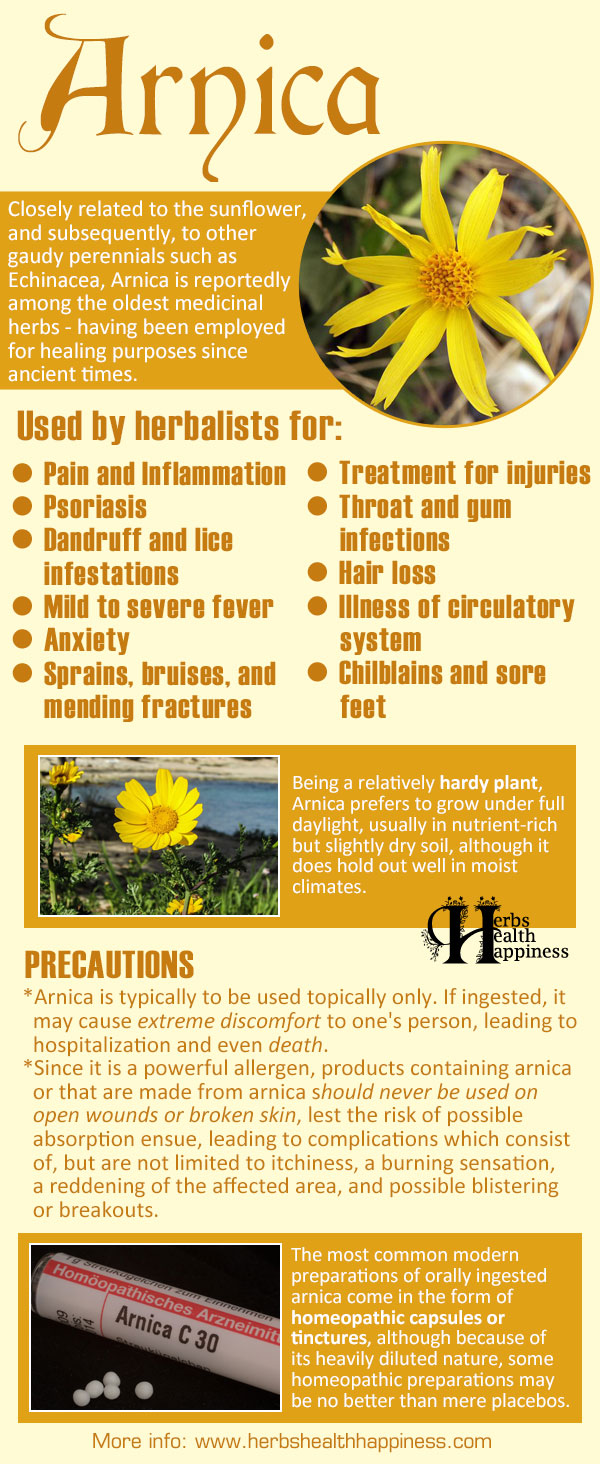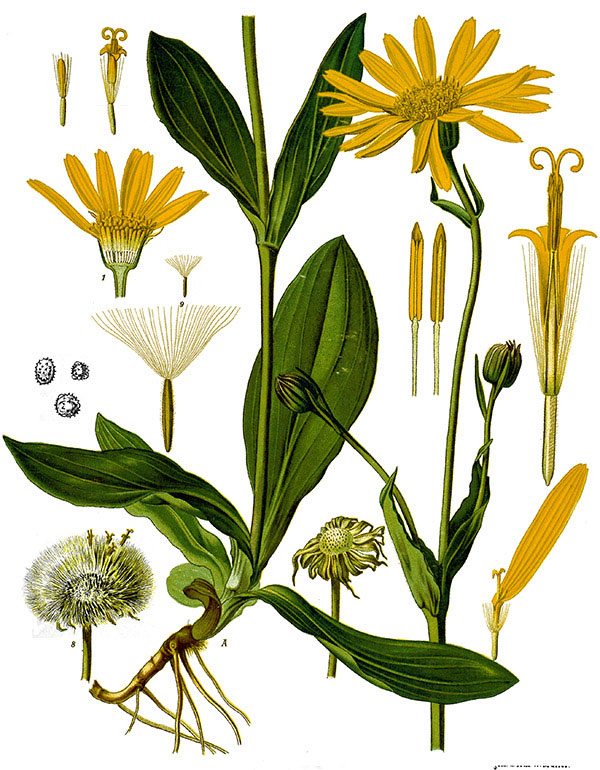Arnica

Arnica - Uses and Benefits. Infographic: herbshealthhappiness.com. Photo credits: See foot of article

Arnica - Botany And History
Arnica is a flowering herbaceous perennial composed of some thirty different species. Closely related to the sunflower, and subsequently, to other gaudy perennials such as Echinacea, arnica is reportedly among the oldest medicinal herbs - having been employed for healing purposes since ancient times, although this suggestion is contested by some modern-day herbalists, who claim that while arnica is an undoubtedly ancient plant, the applications for which it has been employed may have been dissimilar to how it is used today.
Thought to be a native to the northern parts of the Americas and a wide area of Eurasia, arnica may also be found thriving in a large body of Asian or European countries, having also been employed in such areas for folk remedies since prior to the Industrial Revolution. Being a relatively hardy plant, arnica prefers to grow under full daylight, usually in nutrient-rich but slightly dry soil, although it does hold out well in moist climates. Arnica grows best in mountain environments, preferring to grow in patches on fields, although a number of species may also be found growing in lawns, untended lots, and on roadsides. Due to its hardiness and nearly all-pervasive growth, arnica is often considered a weed in some parts of the world.
Nearly all arnica species are characterised by their bushy appearance, replete with erect, hardy, often unbranched stems that shoot up, only to divide upon flowering. Arnica is notable for its oval-shaped or slightly fan-shaped, alternately arranged leaves, chiefly due to its leathery texture and the profusion of fine furze that occurs in the lower part of the leaves from which its name was taken. The most telling characteristic of arnica is it's vibrant, yellow-hued to orange-hued flowers. These sizable inflorescences typically measure some six to eight centimeters with between eight to fifteen asymmetrically arranged petals. Just like many plants under the sunflower family arnica possesses a central 'furze ball' or disc that is replete with numerous florets, the whole of which is held together by a hairy bract beneath the flowerhead. Arnica also sport tiny fruits, resembling seeds more than actually fruits, which are discernable for their while or dun-hued bristles. While not commonly grown for ornamental use, arnica may be left to thrive if found growing as a weed as is usually collected for the creation of potpourris, usually for the colour, but also for the slight pine-like or sage-like aroma that it exudes when bruised. [1]
Arnica - Herbal Uses
Arnica has long been attributed as an indispensable analgesic for primitive cultures, chiefly due to having been ascribed such properties via the conduit of folkloric herbal medicine. Typically ascribed ancient usage, the employment of arnica as medicine within the Western context may actually have experienced the height of its popularity during the Early Middle Ages until well into the latter days of the Industrial Revolution, although it undoubtedly experienced inevitable ups and down in its popularity and in the commonality of its usage. In the East, arnica has had a longer standing as an herbal medicine, although its applications differ largely from that of the Western methods, with medicinal properties that are sometimes at variance with common Western associations.
Arnica is a known poisonous plant, with even very little of it being ingested causing severe bowel discomforts, and moderate doses even resulting in death. Due to this, its use has been limited to external applications, generally of an analgesic, anti-histaminic, or anti-inflammatory nature. Its toxic nature has limited its widespread use over the years as the ingestion of arnica for therapeutic purposes has been known to be detrimental to health, although traditional medicine (veering largely to the Western sphere of things) have employed arnica as potent ointments, liniments, salves, or unctions for pain management and pain-relief. [2] Due to its powerful anti-inflammatory and analgesic properties, ointments or topical salves made from arnica have been employed since ancient times as an excellent means to cure a wide assortment of muscular discomforts. [3] A simple arnica ointment or liniment may be made by macerating dried arnica flowers in one's choice of base oil or high-proof grain alcohol. When making liniments, a substantial amount of the infused alcohol is mixed with the base oil - a step which is omitted when creating simple ointments. Salves containing arnica may best be made by either mixing its extracted essential oil or a concentrated tincture of arnica into a chosen salve base such as beeswax or shea butter, making sure that it is thoroughly incorporated prior to eliciting solidification through one's chosen methods. Likewise, finely ground arnica flower powder and sometimes even ground roots may be incorporated into the salve or butter for added potency.
In the Eastern sphere of herbal medicine, the roots of the arnica are more valued than its flowers (the exact reverse can be said of the matter in Western herbal medicine), and it is often allowed to steep in distilled spirits to either be applied directly to the skin or the affected area, or to be largely diluted in a neutral liquid such as tea or plain water and ingested in very small amounts to provide pain-relief. Due to the toxicity of arnica, only highly experienced practitioners of Traditional Chinese Medicine advice, or even so much as undertake the preparation of arnica-containing products that are meant for oral ingestion. [4] Outside of the Chinese preference for orally ingested arnica-based medicines, they too create topical liniments, salves, balms, ointments, and lotions which contain arnica, although their macerated mixtures often include a combination of arnica roots and flowers along with a large assortment of other medicinal herbs, usually of the 'warming' or 'Yang' varieties.
It is due to the age-old practice of using arnica as a natural pain-reliever that its employment in the modern field of herbal medicine has maintained a slow but stable presence. Nowadays, topical arnica liniments, ointments and salves are just as widely albeit employing more modern base substances that veer away from natural oils, waxes or esters to avoid that "oily" feeling. [5] Modern arnica gels are often made from concentrated extracts incorporated into a pre-made non-oil-based base, resulting in a far more efficient end-product, but with the added risk of possible allergic reactions or overdose.
When arnica is ingested orally, it is usually first diluted to prevent even the slightest possibility of poisoning or adverse effects. The most common modern preparations of orally ingested arnica come in the form of homeopathic capsules or tinctures, although because of its heavily diluted nature, some homeopathic preparations may be no better than mere placebos. [6] In Traditional Chinese Medicine, trifling amounts of arnica are often integrated into medicinal tea mixtures under the supervision or the direct participation of expert herbalists, although it is nevertheless a considerably risky practice especially for hypersensitive individuals who may have a previously unknown allergy to arnica. Very mild infusions of arnica flower may be employed to treat psoriasis, dandruff, lice infestations, mild to severe fevers, anxiety, and even counteract halitosis, although the risks are far too great for it to be employed safely by an inexpert herbalist despite its being 'approved' by some medical authorities to be safe for such applications. [7] In mediaeval times, mild infusions of arnica was even employed as an emmenagogue, a highly risky abortifacient, and as a means to quicken labour and ease the pain associated with delivery.
Loose arnica may also be employed as a base for poultices or compresses simply by encasing it in cloth and allowing it to be heated via steam. Similarly, the constituent parts may be pounded and a little oil may be added in order to facilitate the faster absorption of its medicinal constituents. Unlike other poultices which may be left on the affected area for maximum therapeutic benefits, poultices containing arnica should only be applied for short durations of time in limited occasions lest allergic reactions occur due to prolonged or repeated contact. [8] Likewise, loose arnica may be strongly decocted or made into a tincture and diluted in a large amount of water to create a rinse or wash that may be applied to sprains, bruises, and mending fractures to hasten healing. A foot soak which contains diluted arnica may be employed as a remedy for chilblains and sore feet, although it should only be done sparingly.
Arnica - Esoteric Uses
Arnica's "nearly miraculous" ability to hasten the healing of bruises, sprains, and even fractures earned it a reputation for being sacred, especially in a number of shamanic practices such as that of the First Peoples of the Americas. Its employment outside of the practical side of early shamanic magick veered towards its being used as an offeratory herb. It is said that some Native American Nations gathered and ritualistically "planted" (in reality, setting the gathered bunch into the ground) in the corners of fields or in places where crops were grown to appease the corn spirits (katchinkas) and guarantee a good harvest for the tribe. [9]

In spite of the fact that it is referred to as "mountain tobacco", it is not actually smoked, although it has been suggested that minute amounts of it have been incorporated into hallucinogenic brews drunk by some tribal healers for entheogenic purposes. The veracity of such claims is, however, difficult to substantiate. In the context of magick, arnica might be employed as an incense to drive away evil spirits or to enhance one's inherent psychic abilities. [10] The practical applications of arnica still apply as esoteric applications even in the modern context, although it is rarely done or much less associated as such nowadays.
Arnica - Contraindications And Safety
While medicinal products containing arnica are carefully prepared under controlled conditions, it is important to be aware that arnica is a dangerous and powerful herb in terms of casual use. If ingested, it may cause extreme discomfort to one's person, leading to hospitalization and (in cases of substantial oral ingestion of plant matter) even death. Even the minutest amount of arnica can be potentially dangerous, both when employed topically or when ingested orally. While expertly prepared arnica products are generally considered safe, some individuals who suffer from hypersensitivity of the skin may nevertheless experience allergic reactions to topical applications of high-grade arnica. Since it is a powerful allergen, products containing arnica or that are made from arnica should never be used on open wounds or broken skin, lest the risk of possible absorption ensue, leading to complications which consist of, but are not limited to itchiness, a burning sensation, a reddening of the affected area, and possible blistering or breakouts. Due to its toxic nature, casual usage for all individuals regardless of age should be avoided if possible. If usage is a must, professional guidance and even monitoring may be necessary to avoid potential complications. Pregnant and nursing women should avoid arnica and all products which contain even traces of it altogether.
Arnica - Other Names, Past and Present
Greek (etymological): arna (lit. "lamb")
Chinese: shan jin che
Japanese: arunika (transliteration of "arnica")
Korean: aleunika (transliteration of "arnica")
French: arnica des Montagnes / doronic d'Allemagne / fleurs d'arnica / herbeaux Chutes / herbe aux precheurs / plantin des Alpes / quinquina des pauvres / souci des Alpes / tabac des Vosges / tabac des Savoyards
German: arnikabluten / kraftwurz
Swedish: wundkraut
Russian: bergwohlverieih
English: arnica / wolf's bane (not to be confused with aconite) / mountain tobacco / leopard's bane (not to be confused with aconite) / tumbler's cure-all / mountain arnica
Latin (scientific nomenclature): Arnica montana / Arnica helvetica / Doronicum montanum (early nomenclature; other exist, depending on species)

Arnica montanaIllustration - Köhlers Medizinal-Pflanzen (1887) (PD)
References:
[1] https://en.wikipedia.org/wiki/Arnica
[2] https://umm.edu/health/medical/altmed/herb/arnica
[3] https://www.webmd.com/vitamins-supplements/ingredientmono-721-arnica.aspx
[4] https://botanical.com/botanical/mgmh/a/arnic058.html
[5] https://www.dailymail.co.uk/health/article-160090/Does-Arnica-really-work.html
[6] https://altmedicine.about.com/od/herbsupplementguide/a/arnica.htm
[7] https://www.medicinehunter.com/arnica
[8] https://www.naturalnews.com/029118_arnica_healing.html
[9] https://spiritwalkministry.com/plants_and_herbs
[10] https://herbalriot.tumblr.com/post/67898583059/magickal-uses-of-arnica
Main article researched and created by Alexander Leonhardt.
© herbshealthhappiness.com
Image Sources:
https://en.wikipedia.org/wiki/File:Arnica_griscomii.jpg (CC) https://pixabay.com/en/arnica-flower-blossom-nature-flora-1220585/ https://pixabay.com/en/homeopathy-globuli-naturopaths-1409029/


1. Famous Chef Sheds 60lbs Researching New Paleo Recipes: Get The Cookbook FREE Here
2. #1 muscle that eliminates joint and back pain, anxiety and looking fat
3. Drink THIS first thing in the morning (3 major benefits)
4. [PROOF] Reverse Diabetes with a "Pancreas Jumpstart"
5. Why Some People LOOK Fat that Aren't
6. Amazing Secret Techniques To Protect Your Home From Thieves, Looters And Thugs
7. The #1 WORST food that CAUSES Faster Aging (beware -- Are you eating this?)
If you enjoyed this page:































